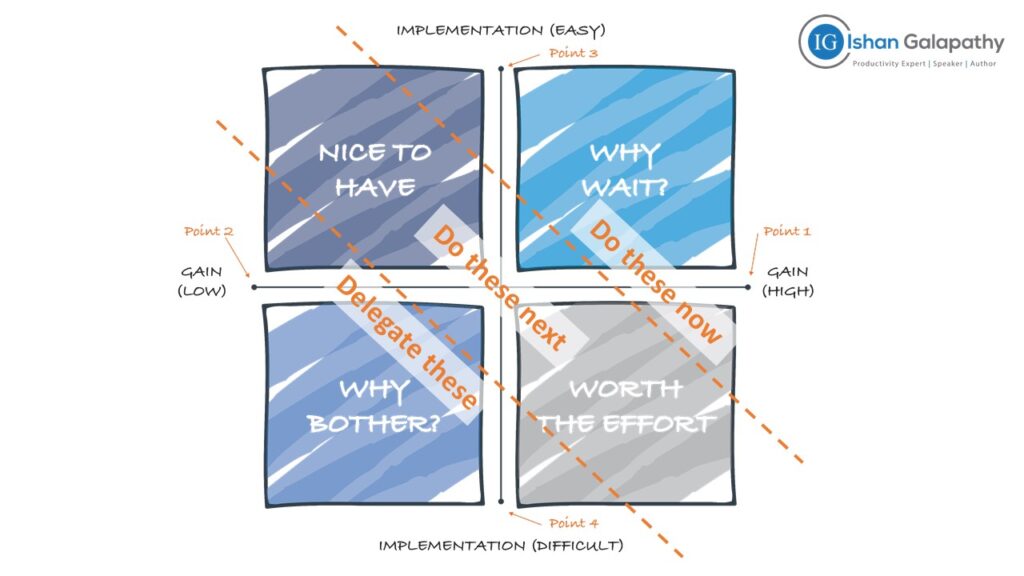Last week, I shared a universal framework on how to identify improvement opportunities – areas, activities and tasks where we are wasting resources in business and life energy in ourselves. Once we learn such techniques the problem shifts from being blissfully ignorant, to seeing inefficiencies everywhere – at work, in the supermarket, at the service stations and definitely at home. It is not uncommon to feel paralysed and inactive when we are overwhelmed with the to-do list! So, the question begs; how do we prioritise our priorities practically?
Let’s assume you now have a long list of issues/tasks to be worked on, to improve productivity. Here are three approaches you can take.
1ST APPROACH: 4 DECISIONS

First, let me explain the axes. The horizontal X axis is the gain, which is the benefit delivered once the initiative is implemented. This can be measured in annualised dollar savings, in a business scenario, or the benefit to you personally, if working on your personal productivity. The vertical Y axis is the ease of implementing the idea – how much effort and time would be required to get these done.
These two axes provide the four types of priority categories: ‘Why Wait?’, ‘Worth the Effort’, ‘Nice to Have’, and ‘Why Bother?’. Let me explain these briefly.
Why Wait? – these are the quick wins and should be your first priority; they are easy to implement with a high return. I also call these the ‘Nike’ projects after its popular slogan, ‘Just Do It’.
Why Bother? – the tasks are the next easiest to prioritise for me. The delete list as these take a lot of effort for no significant benefit.
Nice to Have – these initiatives are easy to implement but there’s not a lot of benefit to them. These initiatives are good when you have little resources and time. Completing these can be a real motivational driver, as you get a sense of progress by ticking things off from the list.
Worth the Effort – these are great when you have resources available. Typically, these are the major constraints or sacred cows that haven’t been tackled yet. So be aware, they may drain a lot more resources than anticipated, but will liberate you once completed.
If you write down your initiatives/tasks on post it notes, you could easily move them around, relative to each other, and place them into our framework. However, there’s a small practical issue as the ‘high / low’ and ‘easy / difficult’ labels on the axes are subjective. So, let’s remove the subjectivity of the framework axes.
Grab your list of initiatives/tasks and let’s define the extreme ends of the axes, by asking these four questions (these are the four points shown in the diagram above):
Highest gain: Which initiative from my list will deliver the highest benefit? You could also ask: if I am only allowed to implement one initiative/task based purely on the benefit, which one would I choose? Write down this initiative number (from your list) in the extreme right position of the X axis. You now have a ‘measure’ for highest gain – point 1.
Lowest gain: What initiative will deliver the least benefit? You could also ask: if I had to remove one initiative based on the benefit it delivers, which one would I drop? Note this initiative number on the extreme left position of the X axis – point 2.
Easiest implementation: What is the easiest project to implement? Evaluate the easiest from the list. Again, write this number on the topmost position of the Y axis – point 3.
Most difficult implementation: What initiative is the most difficult to implement? You could also ask: which initiative would I drop due to difficulty of implementation? Write the initiative number on the lowest point of the vertical axis – point 4.
Your subjective framework is now an objective one. Once the four corners are defined it becomes somewhat easier to place the Post-It notes as you now have reference points.
2ND APPROACH: 3 DECISIONS
While the above quadrant model looks good and sounds simple, often we’re torn between the ‘Nice to Have’ and ‘Worth the Effort’ quadrants – which one takes priority? To remove this fight within us I prioritise these into three categories by drawing two parallel lines as shown. Do this only after you’ve placed all the Post-It notes into the four quadrants. We’ve reduced the complexity by establishing three priority categories – Do it Now, Do it Next and Delegate.
On the top right part are definitely the first priority initiatives, so do these now. On the bottom left are the initiatives and tasks that are not worth the effort and ideally, you’d want to delegate these where possible or deprioritise completely. The task and initiatives that fall into the middle band are the ones to do next, once you’ve completed the first priority tasks. Hope you find this approach easier and a tad more practical.
3RD APPROACH: 2 DECISIONS
If it is still difficult to prioritise, then I’ve got the easiest method for you. The two-category method – the yes / no approach. Remember, “What you say ‘no’ to is more important than what you say ‘yes’ to”.





